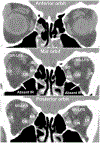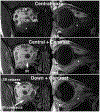Clinical and imaging features of congenital and acquired isolated inferior rectus muscle hypofunction
- PMID: 33601045
- PMCID: PMC8169540
- DOI: 10.1016/j.jaapos.2020.09.007
Clinical and imaging features of congenital and acquired isolated inferior rectus muscle hypofunction
Abstract
Background: Inferior rectus (IR) underaction may arise from various causes that are distinguishable through imaging. We investigated clinical and imaging characteristics of congenital and acquired causes of IR underaction.
Methods: Cases of IR underaction were selected from data prospectively collected in a study of orbital imaging in strabismic patients.
Results: Review identified 3 cases of congenital IR underaction (2 with bilateral IR aplasia and 1 with unilateral IR hypoplasia), 12 acquired cases, including 4 due to denervation (2 idiopathic, 1 after multiple strabismus surgeries, 1 after head trauma), and 8 cases of direct IR damage (5 with orbital trauma and 3 with previous surgery, including 2 sinus surgery and 1 laser blepharoplasty). Of the 23 cases, 11 adults had high-resolution magnetic resonance imaging, and 2 children had computed tomography. Imaging identified the anatomic diagnosis in congenital cases; in acquired cases, imaging helped to identify atrophy and exclude alternative orbital causes; and in direct mechanical damage, imaging clarified the mechanism of underaction, extent of IR damaged, and the degree of retained contractility. Patients with congenital IR absence or hypoplasia exhibited A pattern exotropia that was typically absent in isolated acquired denervation or direct IR damage.
Conclusions: Orbital imaging demonstrates a variety of abnormalities in patients with congenital or acquired IR hypofunction, helping to clarify the underlying mechanism and guide management.
Copyright © 2021 American Association for Pediatric Ophthalmology and Strabismus. Published by Elsevier Inc. All rights reserved.
Figures










Similar articles
-
Clinical findings, orbital imaging, and intraoperative findings in patients with isolated inferior rectus muscle paresis or underaction.J AAPOS. 2012 Aug;16(4):345-9. doi: 10.1016/j.jaapos.2012.03.003. Epub 2012 Jul 21. J AAPOS. 2012. PMID: 22824489
-
Clinical findings, orbital imaging, and intraoperative findings in patients with isolated inferior rectus muscle paresis or underaction.J AAPOS. 2013 Feb;17(1):114. doi: 10.1016/j.jaapos.2012.09.006. Epub 2012 Dec 20. J AAPOS. 2013. PMID: 23260486 No abstract available.
-
Clinical features and surgical outcomes of isolated inferior rectus muscle paralysis.Strabismus. 2014 Jun;22(2):58-63. doi: 10.3109/09273972.2014.904897. Epub 2014 Apr 17. Strabismus. 2014. PMID: 24738952
-
An Approach to Some Aspects of Strabismus from Ocular and Orbital Trauma.Middle East Afr J Ophthalmol. 2015 Jul-Sep;22(3):312-9. doi: 10.4103/0974-9233.159732. Middle East Afr J Ophthalmol. 2015. PMID: 26180469 Free PMC article. Review.
-
Aplasia of the inferior rectus muscle. A case report and review of the literature.Ophthalmology. 1997 Mar;104(3):415-8. doi: 10.1016/s0161-6420(97)30299-1. Ophthalmology. 1997. PMID: 9082265 Review.
Cited by
-
A Promising Outcome of the Augmented Modified Hummelsheim Procedure in a Challenging Case of Inferior Rectus Hypoplasia.Turk J Ophthalmol. 2025 Jun 25;55(3):171-173. doi: 10.4274/tjo.galenos.2025.46735. Turk J Ophthalmol. 2025. PMID: 40560154 Free PMC article. No abstract available.
-
Isolated Ischemic Inferior Rectus Paresis Related to Patent Foramen Ovale.Neuroophthalmology. 2024 Jan 26;48(4):304-308. doi: 10.1080/01658107.2024.2308545. eCollection 2024. Neuroophthalmology. 2024. PMID: 38933753 Free PMC article.
References
-
- Chou TM, Demer JL. Isolated inferior rectus palsy caused by a metastasis to the oculomotor nucleus. Am J Ophthalmol 1998;126:737–40. - PubMed
-
- Akbari MR, Ameri A, Keshtkar Jaafari A, Fard MA, Eshraghi B, Mirmohammadsadeghi A. Clinical features and surgical outcomes of isolated inferior rectus muscle paralysis. Strabismus 2014;22:58–63. - PubMed
-
- Awadein A Clinical findings, orbital imaging, and intraoperative findings in patients with isolated inferior rectus muscle paresis or underaction. J AAPOS 2012;16:345–9. - PubMed
Publication types
MeSH terms
Grants and funding
LinkOut - more resources
Full Text Sources
Other Literature Sources

